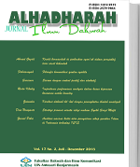Da’wah Cultural Through The Tolak Bala Ritual In Kuin Besar Village
DOI:
https://doi.org/10.18592/alhadharah.v22i1.7528Keywords:
tolak bala ritual, da’wah value, da’wah culturalAbstract
The Tolak Bala ritual in Kuin Besar Village pray for safety and protection from God so that they are safe, protected from all kinds of disaster. This ritual will be seen from an anthropological religion approach where the object is the diversity of society, which is empirical, appears to be valid and not based on right or wrong judgments. So how does the Tolak Bala ritual become part of the urang banjar culture and the values contained therein are analyzed in depth. This research is a field research with data collection methods, namely observation and interviews. The results of the study show that the Tolak Bala ritual is a culture which is embodied in cultural systems, social systems and artifacts. This ritual also represents solidarity, the situation is okay, a harmonious condition among its citizens. There are da'wah values in this ritual, namely strengthening friendship, giving thanks, covering the genitals, inviting the community to give alms, working together and holding deliberations. With these positive values, the tradition of Tolak Bala reinforcements can be used as a medium for preaching or commonly called da’wah cultural.References
Addrianus Josef LoisChoFeer, Diaz Restu Darmawan. 2021. “Ritual Tolak Bala Sebagai Adaptasi Masyarakat Dayak Desa Umin Dalam Menghadapi Pandemi Di Kabupaten Sintang.” Jurnal Pendidikan Sosiologi Dan Antropologi Vol. 5 No.: 53–68.
Daud, Alfani. 1997. Islam & Masyarakat Banjar: Diskripsi dan Analisa Kebudayaan Banjar. Jakarta: Raja Grafindo Persada.
Dwi Fajri, Risanaldi, and U. Saepudin. 2022. “Implikasi Pedidikan Dari Quran Surat Ar-Ra’d Ayat 11 Tentang Perubahan Terhadap Upaya Pendidikan Dalam Mengembangkan Potensi Manusia.” Bandung Conference Series: Islamic Education 2 (1): 100–106. https://doi.org/10.29313/bcsied.v2i1.2161
Djandon, Maria Goretty. 2021. “Kolu Lanu Sebagai Upacara Tolak Bala Pada Masyarakat Adat Jawamaghi Di Desa Sobo Kecamatan Golewa Barat Kabupaten Ngada.” Jurnal Historis Vol. 6, No: 1–10. https://journal.ummat.ac.id/index.php/historis/article/view/6818/pdf.
Fitriani, SutiknoRahmat Kartolo Enny. 2019. Perubahan dan Kesinambungan Fungsi Makna Ritual Tolak Bala dalam Masyarakat Melayu Serdang. Diedit oleh M.Pd. Tiflatul Husna, S.Pd. Medan: Pustaka Diksi.
Hadikusuma, Hilman. 1993. Antropologi Agama Bagian I. Bandung: PT. Citra Aditya Bakti.
Hakim, Awaludin. 2017. “Doa Dalam Perspektif Alquran Kajian Tafsīr Ibnu Kathῑr Dan Tafsīr Al-Azhar.” Jurnal Al-Fath 11 (01): 50–51
Ihromi, T.O, ed. 1984. Pokok-Pokok Antropologi Budaya. Jakarta: PT Gramedia
Jamalie, Zulfa. 2020. “Materi Pembelajaran Daring Islam dan Budaya Lokal,” 1–2.
Keesing, Roger M. 1981. Cultural Anthropology A Contemporary Perspective. Jakarta: Erlangga.
Koentjaranigrat. 1990. Beberapa Pokok Antropologi Sosial. Jakarta: Dian Rakyat.
Koentjaraningrat. 1987. Sejarah Teori Antropologi. Jakarta: Universitas Indonesia.
Koentjaraningrat. 2011. Pengantar Antropologi. Jakarta: Rinneka Cipta.
Ningsih, Tutuk. 2019. “Tradisi Saparan Dalam Budaya Masyarakat Jawa Di Lumajang.” Ibda’ Jurnal Kajian Islam dan Budaya 17 N0. 1: 79–93. https://ejournal.uinsaizu.ac.id/index.php/ibda/article/view/1982.
Nirwan Wahyudi AR. 2020. “Dakwah Kultural Melalui Tradisi Akkorongtigi.” Al-Mutsla 2 (1): 39–55. https://doi.org/10.46870/almutsla.v2i1.48.
Nurhasanah Nur, Muhammad Syahran Jailani. 2020. “Tradisi Ritual Bepapai Suku Banjar: Mandi Tolak Bala Calon Pengantin Suku Banjar Kuala-Tungkal Provinsi Jambi, Indonesia.” Khazanah : Jurnal Studi Islam Dan Humaniora Vol 18
Pramayoza, Dede. 2021. “Dramaturgi Bakaua dalam Masyarakat Minangkabau : Studi Atas Ritual Tolak Bala Dengan Perspektif Victor Turner.” Bercadik Jurnal Pengkajian dan Penciptaan Seni Vol 5 No. http://www.journal.isi-padangpanjang.ac.id/index.php/Bercadik/article/view/2493/937.
Roibin, H. 2009. Relasi Agama Dan Budaya Masyarakat Kontemporer. Malang: UIN-Malang Press.
wikipedia. 2023. "Suku Banjar."2023. https://id.wikipedia.org/wiki/Suku_Banjar
Downloads
Published
How to Cite
Issue
Section
License
Authors retain copyright and grant the journal the right of first publication, with the work simultaneously licensed under the Creative Commons Attribution-NonCommercial 4.0 International Public License (CC BY-NC 4.0). This license allows reusers to distribute, remix, adapt, and build upon the material in any medium or format for noncommercial purposes only, provided that proper attribution is given to the original creator.







